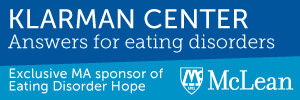- Calls to this hotline are currently being directed to Within Health, Fay or Eating Disorder Solutions
- Representatives are standing by 24/7 to help answer your questions
- All calls are confidential and HIPAA compliant
- There is no obligation or cost to call
- Eating Disorder Hope does not receive any commissions or fees dependent upon which provider you select
- Additional treatment providers are located on our directory or samhsa.gov
Peeling an Onion in the Psychotherapy of Patients with Eating Disorders

Early in medical school, every medical student learns how to present a patient case. Using an example of a patient with Anorexia Nervosa, the presentation might go like this: L is a 16 year old high school sophomore who developed AN in the Spring of 2020. She reported longstanding negative body image, and some history of dieting and disordered eating. However with the stress of the COVID-19 pandemic, she became isolated and depressed. She began to exercise excessively and lose weight to help cope with her stress. Her efforts led to a 20# weight loss, and she reported that it became increasingly difficult to eat. On hospital admission, she was eating 1000 Kcals a day of limited food variety and exercising three hours daily. L and her parents report that she is also depressed, anxious and not sleeping. L has a low heart rate of 37 beats a minute and stopped menstruating three months ago.
Medical students are taught to be clear and concise, and to paint a picture of the patient in front of you. Despite the value of brevity, in the care and treatment of patients with eating disorder, what is not known is usually as important as what is known.
At first glance, the eating disorders of Anorexia Nervosa and Bulimia Nervosa seem to be about food and body. For both Anorexia Nervosa and Bulimia Nervosa, patients have an impaired relationship with food and eating. They have behaviors of restricting, avoiding food groups, exercising to lose weight, purging, bingeing, following rules about food and eating. In addition, patients report distress about their bodies, and often have body distortion. As an example of body distortion, when patients look in the mirror they often report looking bigger than they are (reference Treasure).
But what else is the patient up against? How did the eating disorder arise? What problems are the eating disorder helping a patient with? What else was there (illnesses and stressors) prior to the eating disorder that need to be treated?
Eating disorders are often the tip of the iceberg or the canary in the coal mine which signals other troubles. Most patients with eating disorder have at least one comorbid psychiatric condition. Common comorbid conditions include depressive disorders, anxiety disorders, substance use disorders, and impulse control disorders (reference Kessler). Trauma which can include sexual assault and adverse childhood experiences are commonly reported in patients with eating disorders. Many patients report stressors, including bullying, teasing or exclusion, parental divorce, deaths of family members, parental mental illnesses, academic struggles, and physical illnesses. Finally, all girls and young women grow up in a media milieu (perhaps worse with social media) that portrays a thin ideal for women.
When I was a psychiatric resident learning to do psychotherapy, a psychoanalytic supervisor told me, “doing psychotherapy is like peeling an onion, you go deeper and deeper with each layer”. In this metaphor, the attempt is to find out more and more about what is underneath the surface, not readily known or understood. As each layer is revealed, rather than summarizing or drawing conclusions, one continues to explore deeper with the patient. The end goal is to help the patient understand their unconscious mind (thoughts and feelings not readily available to them). This open-ended process works best when curiosity is valued and judgement suspended. Thus through the process of psychotherapy, the therapist and patient begin to peel the onion, and to create a narrative in which the young woman understands and puts in context her eating disorder symptoms. From her unique narrative, treatment for not only the eating disorder, but what lies underneath the eating disorder, can take place. In the words of a patient, “my eating disorder never was about food anyway”.
Resources:
The prevalence and correlates of eating disorders in the National Comorbidity Survey Replication.Hudson JI, Hiripi E, Pope HG Jr, Kessler RC.Biol Psychiatry. 2007 Feb 1;61(3):348-58
Functional neuroanatomy of body shape perception in healthy and eating-disordered women. Uher R, Murphy T, Friederich HC, Dalgleish T, Brammer MJ, Giampietro V, Phillips ML, Andrew CM, Ng VW, Williams SC, Campbell IC, Treasure J.Biol Psychiatry. 2005 Dec 15;58(12):990-7
About the Sponsor:
 The Klarman Eating Disorders Center (KEDC) at McLean Hospital provides state-of-the-art treatment for young women ages 16 to 26. Our programs specialize in the treatment of anorexia nervosa, bulimia nervosa, and binge eating disorder. The KEDC also specializes in treating coexisting mental health conditions such as depression, anxiety, and addiction. We engage parents, siblings, and other loved ones in therapy, education, and close communication to help realize the common goal of a healthy recovery.
The Klarman Eating Disorders Center (KEDC) at McLean Hospital provides state-of-the-art treatment for young women ages 16 to 26. Our programs specialize in the treatment of anorexia nervosa, bulimia nervosa, and binge eating disorder. The KEDC also specializes in treating coexisting mental health conditions such as depression, anxiety, and addiction. We engage parents, siblings, and other loved ones in therapy, education, and close communication to help realize the common goal of a healthy recovery.
About the Author:

Esther Dechant, MD, received her medical degree from Harvard Medical School. She completed the residency program in psychiatry at Cambridge Hospital and a fellowship in child and adolescent psychiatry at Massachusetts General Hospital and McLean Hospital. Board-certified by the American Board of Psychiatry and Neurology in psychiatry with subspecialty certification in child and adolescent psychiatry, Dr. Dechant is experienced in child, adolescent, and adult medication evaluation and management and psychotherapy.
Dr. Dechant currently serves as the medical director for the Klarman Eating Disorders Center and holds an appointment as an assistant professor in psychiatry at Harvard Medical School. Her private practice specializes in child, adolescent, and adult psychotherapy, as well as child and adolescent medication evaluation and management.
The opinions and views of our guest contributors are shared to provide a broad perspective of eating disorders. These are not necessarily the views of Eating Disorder Hope, but an effort to offer a discussion of various issues by different concerned individuals.
We at Eating Disorder Hope understand that eating disorders result from a combination of environmental and genetic factors. If you or a loved one are suffering from an eating disorder, please know that there is hope for you, and seek immediate professional help.
Reviewed & Approved on May 27th, 2021, by Jacquelyn Ekern MS, LPC
Published May 27th, 2021 on EatingDisorderHope.com

The EatingDisorderHope.com editorial team comprises experienced writers, editors, and medical reviewers specializing in eating disorders, treatment, and mental and behavioral health.

